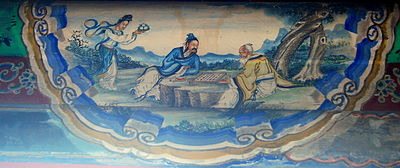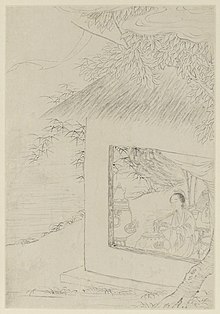Magu (deity)

Magu (
Name
The logographic meaning of Magu as Hemp Goddess remains to be explored.[according to whom?] Magu is called Mago in Korean and Mako in Japanese. In Japan, Mako is usually referenced in connection to the Chinese story (below) about Magu's long fingernails, for instance, the phrase Mako sōyō (麻姑掻痒 "Magu scratches the itch") metaphorically means "things going like one imagined".[citation needed]
Cultic origins
While Magu folktales are familiar in East Asia, the sociologist
Early descriptions

Scholar Robert Campany provides details of Magu mythology in his annotated translation of
In the Traditions of Divine Transcendents, a story about Wang Yuan (王遠) contains the longest early descriptions of her. Wang was supposedly a Confucianist scholar who quit his official post during the reign (146–168 CE) of
She appeared to be a handsome woman of eighteen or nineteen; her hair was done up, and several loose strands hung down to her waist. Her gown had a pattern of colors, but it was not woven; it shimmered, dazzling the eyes, and was indescribable – it was not of this world. She approached and bowed to Wang, who bade her rise. When they were both seated, they called for the travelling canteen. The servings were piled up on gold platters and in jade cups without limit. There were rare delicacies, many of them made from flowers and fruits, and their fragrance permeated the air inside [Cai's home] and out. When the meat was sliced and served, [in flavor] it resembled broiled mo, and was announced as kirin meat.
Maid Ma declared: "Since I entered your service, I have seen the Eastern Sea turn to mulberry fields three times. As one proceeded across to Penglai, the water came only up to one's waist. I wonder whether it will turn to dry land once again." Wang answered with a sigh, "Oh, the sages all say that the Eastern Sea will once again become blowing dust."[5]
This "traveling canteen" is the
Magu legends frequently mention these mulberry fields in the
Maid Ma's fingernails resembled bird claws. When Cai Jing noticed them, he thought to himself, "My back itches. Wouldn't it be great if I could get her to scratch my back with those nails?" Now, Wang Yuan knew what Cai was saying in his heart, so he ordered him bound and whipped, chiding, "Maid Ma is a divine personage. How dare you think that her nails could scratch your back!" The whip lashing Cai's back was the only thing visible; no one was seen wielding it. Wang added, "My whippings are not given without cause."[7]
Some later versions of this legend say Ma was Wang's sister. The poet Li Bai immortalized two Classical Chinese expressions from this story. Magu saobei (麻姑掻背 "Magu scratches [my] back") refers to her extraordinary fingernails. Canghai sangtian (滄海桑田 "blue ocean [turns to] mulberry fields") means "great changes over the course of time"; Needham says early Daoists observed seashells in mountainous rocks and recognized the vast scale of geologic transformations.[8]
The Lieyi zhuan (列異傳 "Arrayed Marvels", late 2nd or early 3rd century), attributed to Cao Pi (187–226 CE) has three stories about Wang Fangping.
The third gives a version of the incident of Cai Jing's inappropriate fantasy concerning Maid Ma and her luxuriant four-inch nails. Here, Cai Jing's home is located in Dongyang; he is not whipped but rather flung to the ground, his eyes running blood; and Maid Ma herself, identified as "a divine transcendent" (shenxian), is the one who reads his thoughts and does the punishing.[9]
Kohn includes a woodblock from the illustrated Zengxiang Liexian zhuan.[10]
The Yiyuan (異苑 "Garden of Marvels", early 5th century), by Liu Jingshu (劉敬叔), records a story about Meigu (梅姑 "Plum Maid") or Magu, and suggests her cult originated during the Qin dynasty (221–206 BCE).
During Qin times, there was a Temple to Maid Mei 梅 – or, as one version has it, Maid Ma – beside a lake. When alive, she had possessed arts of the Dao. She could walk on water in her shoes. Later she violated the laws of the Dao, and her husband, out of anger, murdered her and dumped her body in the lake. Following the current, it floated on the waves until it reached the [present site of] the temple. A subordinate shaman directed that she be encoffined but not immediately buried. Very soon a square, lacquered coffin appeared in the shrine hall. [From then on], at the end and beginning of each lunar month, people there could make out through the fog an indistinct figure, wearing shoes. Fishing and hunting were prohibited in the area of the temple, and violators would always become lost or drown. Shamans said that it was because the Maid had suffered a painful death and hates to see other beings cruelly killed.[11]
Campany reads this legend to describe founding a temple, probably on Lake Gongting, and translates these "shaman" and "shrine" references in the future tense. Compare the present tense translation of Miyakawa who interprets her body floating to an existing temple.[12]
The Qi Xie ji (齊諧記, 6th century) associates Magu with snakes. It describes her as a commoner from
This story hints at an even older stratum of legend behind the Maid Ma cult: like other territorial gods known to Chinese religious history, she may have begun as a theriomorphic deity (perhaps snake-headed) who gradually metamorphosed into a human being and finally – the process culminating in Ge Hong's Traditions narrative – into a full-fledged transcendent. Seen in this light, several details of the Traditions hagiography might be read as betraying these chthonic origins. Among these are Maid Ma's long nails, the featuring of meat dishes among the fantastic foods served by the travelling canteen, and the scene describing the "summoning" of Maid Ma, which is reminiscent of shamanic invocations of deities to attend spirit-writing sessions.[13]
Hemp goddess

| Part of a series on |
| Cannabis |
|---|
 |
Hellmut Wilhelm's book review of Eberhard's original German book suggested that Magu was associated with cannabis.[14] Eberhard dismissed this hypothesis in the English version.
I have no indication that the goddess ever was a goddess of the hemp plant (ma) as H. Wilhelm surmised (Monumenta Serica vol. 9, p. 213 note 9). She often wears aboriginal attire, a dress with a collar made of leaves, but not of hemp, which only sometimes has developed, according to a late fashion into a cape of cloth.[15]
Campany mentions the Chinese use of ma "hemp" fibers as a weaving material. "(Note also her shimmering, multicolored gown, "not of this world"; but we are told that it was not woven, at least not in an ordinary way.) I know of no attempt to explain the name Ma gu (literally, "the Hemp Maiden")."[16]
The historian and sinologist
The Shangqing School of Taoism provides a good example. Yang Xi (330-c. 386 CE) was "aided almost certainly by cannabis"[20] in writing the Shangqing scriptures during nightly visitations by Taoist "immortals". Tao Hongjing (456–536 CE), who edited the official Shangqing canon, also recorded, "Hemp-seeds ([mabo] 麻勃) are very little used in medicine, but the magician-technicians ([shujia] 術家) say that if one consumes them with ginseng it will give one preternatural knowledge of events in the future."[21]
Needham concluded,
Thus all in all there is much reason for thinking that the ancient Taoists experimented systematically with hallucinogenic smokes, using techniques which arose directly out of liturgical observance. … At all events the incense-burner remained the centre of changes and transformations associated with worship, sacrifice, ascending perfume of sweet savour, fire, combustion, disintegration, transformation, vision, communication with spiritual beings, and assurances of immortality. Wai tan and nei tan met around the incense-burner. Might one not indeed think of it as their point of origin?[22]
Korea
Mago appears in a number of sources, including the academically disputed Budoji, folklore, place-names, art, classical literature, folksongs, shamanic songs (muga), historical and religious texts, and miscellaneous data.[23] Mago features prominently in the writings of several modern Korean pseudohistorians.[24]
A small number of folkloric narratives from Korea associate Mago with hemp, and according to the pseudo historical work Budoji, Korean mytho-history began with the "Era of Mago". In one story, Mago is portrayed as the cosmic weaver who descends in the region (Jinhae, South Gyeongsang) to herald the season of weaving hemp. In other stories, she is said to be the giant cosmogonist, weaving with islands and rocks taking as the spindle and the loom shuttle. Undoubtedly, Magoists regarded hemp as a sacred plant and used it for various purposes (food, clothes, medicines, and rituals). It was also used as means of currency from the time of Joseon (2333–232 BCE).[25]
See also
- He Xiangu
- Mulberry fields (idiom)
- Queen Mother of the West
- Shen (Chinese religion)
- Wei Huacun
- Xian (Taoism)
Bibliography
- Campany, Robert Ford (2002). To Live As Long As Heaven and Earth: Ge Hong's Traditions of Divine Transcendents. University of California Press.
- Eberhard, Wolfram (1968) [1943]. The Local Cultures of South and East China. E.J. Brill. OCLC 1006434315.
- Li, Hui-lin (1974). "An archaeological and historical account of cannabis in China". Economic Botany. 28 (4): 437–47. S2CID 19866569.
- Needham, Joseph (1974). "Volume 5, Chemistry and Chemical Technology; Part 2, Spagyrical Discovery and Invention: Magisteries of Gold and Immortality". Science and Civilisation in China. Cambridge University Press. ISBN 9780521085717.
- Wilhelm, Hellmut (1944). "[Review of] "Wolfram Eberhard: Untersuchungen über den Aufbau der chinesischen Kultur II. Teil 2: Die Lokalkulturen des Südens und Ostens"". Monumenta Serica. 9: 209–230. .
Footnotes
- ^ Eberhard 1968, pp. 123–6.
- ^ a b Eberhard 1968, p. 124.
- .
- ^ Campany 2002, pp. 259–70.
- ^ Campany 2002, p. 262.
- ISBN 0600006379.
- ^ Campany 2002, p. 263.
- ^ Needham, Joseph (1959). "Vol. 3, Mathematics and the Sciences of the Heavens and the Earth". Science and Civilisation in China. Cambridge University Press. pp. 599–600.
- ^ Campany 2002, p. 268.
- ^ Kohn, Livia (1993). The Taoist Experience: An Anthology. State University of New York Press. pp. 355–8, "The Hemp Lady".
- ^ Campany 2002, p. 269.
- ^ Miyakawa, Hisayuki (1979). "Local Cults around Mount Lu at the Time of Sun En's Rebellion". In Welch, Holmes; Seidel, Anna (eds.). Facets of Taoism: Essays in Chinese Religion. New Haven: Yale University Press. p. 86 (83–102)..
- ^ Campany 2002, pp. 269–70.
- ^ Wilhelm 1944, p. 213.
- ^ Eberhard 1968, p. 125.
- ^ Campany 2002, p. 267, fn. 487.
- ^ Bretschneider, Emil (1895). "Botanicon Sinicum: Notes on Chinese Botany from Native and Western Sources. Part III, Botanical Investigations in the Materia Medica of the Ancient Chinese". Journal of the China Branch of the Royal Asiatic Society. XXIX (new series) (1 – 1894–95). Kelly & Walsh: 378.
- ^ Needham 1974, p. 152.
- ^ Needham 1974, p. 150, "Supreme Secret Essentials".
- ^ Needham 1974, p. 151.
- ^ Mingyi bielu 名醫別錄 "Supplementary Records of Famous Physicians", as cited in Needham 1974, p. 151.
- ^ Needham 1974, p. 154.
- ISBN 1516907922.
- ^ Logie, A. (2019). Diagnosing and Debunking Korean Pseudohistory. European journal of Korean studies, 18(2), 37–80. https://doi.org/10.33526/EJKS.20191802.37
- ISBN 1976331021.
Further reading
- Liu, Ts'un-yan; Berling, Judith (1982). "The 'Three Teachings' in the Mongol-Yuan Period". In Chan, Hok-lam; de Bary, Wm. Theodore (eds.). Yuan Thought: Chinese Thought and Religion under the Mongols. Columbia University Press. pp. 479–512.
- Needham, Joseph (1980). "Volume 5, Chemistry and Chemical Technology; Part 4, Spagyrical Discovery and Invention". Science and Civilisation in China. Cambridge University Press. ISBN 9780521085731.
- Penny, Benjamin (2007). "Magu" 麻姑. In Pregadio, Fabrizio (ed.). The Encyclopedia of Taoism. Routledge. pp. 731–732.
External links
- Ma Gu Temple, Kunyu Mountain Shaolin Martial Arts Academy
- Way of Infinite Harmony website
- Ma Gu Presenting the Peaches, painting by Deng Fen 鄧芬, Hong Kong Museum of Art
- 麻姑山, Daoist sites on Ma Gu Mountain, Jiangxi Bureau of Ethnic Minorities (in Chinese)
